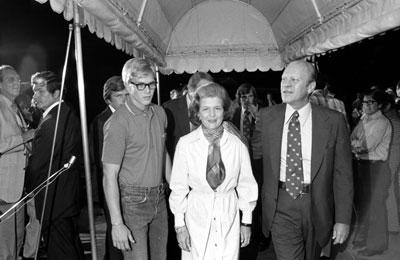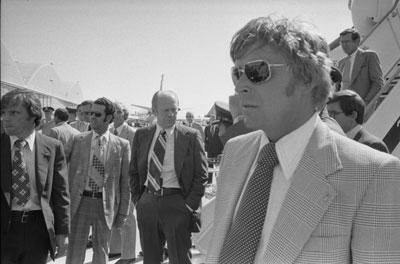 In September 1975, the nation was stunned when President Gerald Ford survived two assassination attempts within just 17 days, both occurring in California and both carried out by women.
In September 1975, the nation was stunned when President Gerald Ford survived two assassination attempts within just 17 days, both occurring in California and both carried out by women.
While unsuccessful, the shootings highlighted the social and political tensions in a country still reeling from the Vietnam War and the Watergate scandal. The year before, Ford had unexpectedly become president when Richard Nixon resigned. Before that he had been appointed to the vice presidency when Spiro Agnew had resigned.
“Ford had come into office under a great wave of popularity, which he enjoyed for the first month—until September 8, 1974, when he pardoned Richard Nixon,” says Mirelle Luecke, supervisory curator for the Gerald R. Ford Presidential Museum in Grand Rapids, Michigan. “Ford “[He] struggled with his popularity ratings after that. The country was also facing the end of the Vietnam War and massive inflation, so it was a time of a lot of change and a lot of difficulty.”
At first, the two assassination attempts against Ford seemed as if they might turn the clock back to the dark days of the 1960s, when the assassinations of John F. Kennedy, Martin Luther King Jr., and Robert F. Kennedy convulsed American politics, according to Ken Hughes, a historian with the University of Virginia’s Miller Center.
“But Ford survived both attempts on his life without so much a scratch, so the assassination attempts did no lasting damage,” he says. “The buzzword was ‘decompression.’ After years of tumult and controversy, the pressure was finally off.”
First Attempt: Sacramento, September 5
First Ford Assassination Attempt
On September 5, 1975, Ford was in Sacramento, California, walking from the Senator Hotel to the nearby California State Capitol for a meeting with then-Governor Jerry Brown. While stopping to shake hands with the crowd, would-be assassin Lynette “Squeaky” Fromme, a member of the Charles Manson Family cult, approached.
“Fromme, age 26, wearing a hand-sewn Little Red Riding Hood outfit and carrying a .45 caliber handgun in an ankle holster, walked up and aimed the gun at the president,” Hughes says. A Secret Service agent disarmed Fromme before she could fire a shot. It turned out she didn’t have a round in the chamber.

According to the Los Angeles Times, Fromme said the attempt was to protest the destruction of the redwoods, which she believed the president was destroying.
“She and another Manson family member had committed to kill corporate or elected polluters of the environment,” Luecke says. “So rather than a response to Ford’s presidency or politics, it was really an outlier event.”
While the event rattled Ford, he continued his day as scheduled, not mentioning it to Brown during their meeting, according to Luecke.
“First lady Betty Ford later recalled that when she learned about the event, her anxiety really deepened, and she talked about worrying about him every time he attended public events after that, and what’s going to happen this time?” she says.
Back at the Senator Hotel, Hughes says, Ford praised the Secret Service for doing a superb job protecting him. The president also emphasized that he wouldn’t let the attempt influence his conduct.
“This incident under no circumstances will prevent me or preclude me from contacting the American people as I travel from one state to another and from one community to another,” Ford said in remarks to reporters on September 5. “In my judgment, it is vitally important for a president to see the American people, and I am going to continue to have that personal contact and relationship with the American people.”
Fromme was convicted on November 26, 1975, of the attempted assassination of a president and sentenced to life in prison. She was released on parole in 2009.
The Secret Service announced “no major changes” following Fromme’s failed assassination attempt. “The attempt on Ford’s life wasn’t the result of some bad policy,” Highes says. “It was the result of a fanatical cult member getting a gun and a president refusing to live in fear.”
Second Attempt, San Francisco, September 22
Second Ford Assassination Attempt
Still, according to Luecke, tensions arose between security personnel and political aides in the days that followed over an invitation Ford had received to deliver a speech at the AFL-CIO convention in San Francisco in a few weeks.
“They had changed protocols a little bit, in that he would go straight from the hotel to the limousine rather than do these walk-arounds that he had done earlier in the month,” she says. “But as he exited the hotel and walked toward his limousine, Sara Jane Moore managed to fire two shots at the president. The first shot missed him by 5 inches and passed through the doorway that he had just exited.”
![SFDB on X: "September 22, 1975: Sara Jane Moore unsuccessfully tries to assassinate President Gerald Ford, the second attempt against Ford's life in 17 days. [Miami Herald - September 23, 1975] https://t.co/iKlFJAtNUt" / X](https://pbs.twimg.com/media/GYE6q5ZXwAAgEgo.jpg)
Bystander Oliver Sipple, a former Marine, heard the first shot and managed to grab Moore’s shooting arm as she pulled the trigger a second time. “That shot went wild,” Leucke says, “and hit another bystander who survived.”
The Secret Service rushed Ford into a limousine and sped away as a San Francisco police officer grabbed Moore.
Leucke says Secret Service agents and Donald Rumsfeld, Ford’s chief of staff, “jumped on top of Ford and laid on top of him as the limousine drove away until he, muffled, said a few blocks away, ‘Hey guys, will you get off? You’re smothering me.’”
A far-left political activist and former FBI informant, Moore, 45, had been arrested two days earlier and was interviewed and released by the Secret Service, according to the Los Angeles Times. She bought the 38-caliber revolver used to shoot at Ford following her release.
“Moore hoped that assassinating the president would somehow change the world,” Hughes says. “She recognized at her sentencing hearing that it didn’t.”
“It accomplished little except to throw away the rest of my life,” Moore said after her sentencing. “And, no, I’m not sorry I tried … because at the time it seemed a correct expression of my anger.”
Convicted of attempted assassination, Moore was sentenced to life in prison and was paroled in 2007.
Aftermath of Assassination Attempts
Following the second attempt, Ford was issued a bullet-proof jacket, now on display at the Gerald R. Ford Presidential Museum. But, in 1977, he said he didn’t like the bulky trench coat with a zip-in Kevlar vest that weighed 6 pounds.
“I would not be honest to say that I took it as a matter of course,” Ford said. “It bothered me and I certainly would have preferred not to (wear) it, but I felt it my obligation to do it.”
In addition to the jacket, the Secret Service tightened its rules, Hughes says, citing Carol Leonnig’s book Zero Fail: The Rise and Fall of the Secret Service. The service tried to maintain 50 feet between the president and unscreened crowds. It also shortened the time it took to get the president into a limousine by having the limo door already open as the president approached the vehicle.
But again, Ford’s reaction to the shooting mirrored his reaction 17 days earlier.
“I don’t think any person as president ought to cower in the face of a limited number of people who want to take the law into their own hands,” the president told reporters after the attempt.
Weekly mail summaries of messages sent to the president regarding the assassination attempts numbered more than 6,500, Leucke says. Most of the messages expressed concern about the president’s travel, given the risk. “The majority were ‘I’m really glad for his safety. I’m glad he’s OK,’” she says. “There were also pro and con messages about gun legislation and things like that.”
But overall, the public took its cue from Ford and his calm reaction to the events.
“Ford did not play up the drama or the danger,” Hughes says. “Instead, he deliberately went about his and the people’s business. He did not let would-be assassins disrupt his presidency or the nation’s life.”